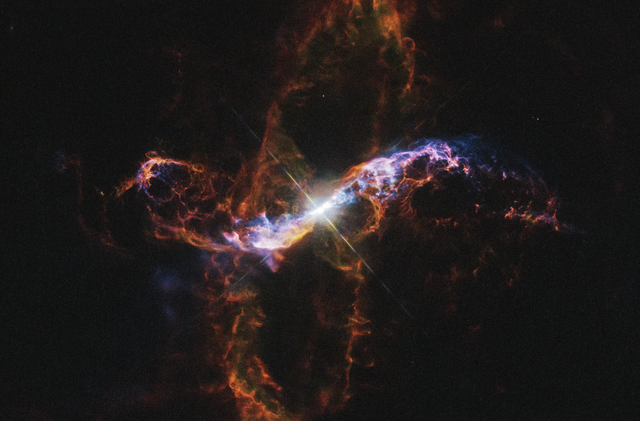Symbiotic R Aquarii. X-ray: NASA/CXC/SAO/R. Montez et al.,
Optical: Data: NASA/ESA/STScI, Processing: Judy Schmidt
I tried to make sense of today's APOD, but it wasn't easy! What do the colors mean? I found the original source of the image
here, but it contained no useful information about the colors of the image. Then I found
this:
Lo and behold, this is a Geckzilla image! Judy Schmidt! And she has written a very interesting caption for this Wikimedia image:
Judy Schmidt wrote:
Last night when I saw Space Telescope Live tweet out that it was looking at this, I thought wow, what a cool-looking thing, can't wait to see Hubble images of it. Then I decided to check the archive to see if it already had, and lo and behold, it had. The telescope seems to be doing somewhat yearly observations of the object to characterize and measure the movement of the jets on this thing.
In 2013, and then in 2014 on this same day Hubble did these observations. I presume it is no coincidence that it is once again looking this year after a three-year gap. Keep it up for a thousand years and you'll have a nice animation! I'm pretty sure movement can be seen by Hubble even with one year intervals, so the jets are quite fast. Surprisingly, the proposal for these observations suggests a twelve-year interval would be good to measure them, but I'm not totally sure the entire twelve years is necessary? Well, I could be mistaken. I was comparing the F502N data from 2013 to the F658N data from 2014, and those are pretty different bands, so it might not be movement.
A few months ago this object was featured on APOD, and now that I look at that image again I do recall seeing it, but wow, what a difference. In the APOD image, which combines ground data from Adam Block, and x-ray data from the Chandra space telescope, one is able to see the outer parts of the nebula which didn't quite fit on Hubble's detector. It's hard to say what shape the nebula is in, but it does remind me of a clumpy version of an hourglass-type nebula, sort of like Hb 12, but with jets too. I feel like there is a lot to learn about this object, but I've only just begun.
This system is curiously bright at certain infrared bands, and I'm not entirely sure why. I'd love to see what JWST makes of this thing. Being such a well-studied object, I would guess that it will eventually become a Webb target.
There were some nice, short exposures I was able to use to clear off the charge bleeds. Some of the nebula was cropped off to satisfy compositional aesthetics, and because it was crossed by the evil chip gap. I rotated the diffraction spikes in the F502N data to match the F658N spikes. It looks a bit less funny that way.
I made use of data from the following proposal: R Aqr: a prototype for non-relativistic astrophysical jets and a key for understanding jet formation
Red: WFC3/UVIS F658N (ic9k07020_drc) Green: WFC3/UVIS F656N (ic9k06020_drc) & WFC3/UVIS F631N (ic9k01020_drc) Blue: WFC3/UVIS F502N (ic9k01010_drc)
North is NOT up. It is 86.18° counter-clockwise from up.
Date 18 October 2017, 23:05
Source Symbiotic System R Aquarii
Author Judy Schmidt from USA
Wow! Judy Schmidt wrote this, our own Geckzilla! Thank you, Geck!
Anyway. In Geck's image,
red means inozed
nitrogen at 658 nm.
Green means
hydrogen alpha at 656 nm.
Blue means ionized
oxygen at 501 nm.
Please note that ionized nitrogen might play a larger role here than H-alpha, at least for the outer structures.
My guess, however, is that the red structures that we are seeing in the APOD are a combination of N II, ionized nitrogen, and Hα. The blue structures are, I suppose, doubly ionized oxygen, OIII.
It seems reasonable to me that the weird orange hue of the red structures in the APOD has been chosen precisely because this color represents both N II and Hα in the APOD.
Ann
 Symbiotic R Aquarii
Symbiotic R Aquarii